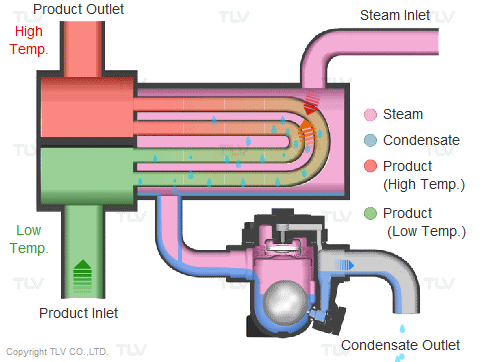Why to Recover Condensate?
Solids, liquids and gases. All three of these materials are likely to play a prominent role in any of the process plants, but there’s one liquid in particular one might not have paid full attention by most of us – 'condensate'.

The best energy-saving measures for most steam heating systems is utilising condensate energy as domestic utility instead of dumping it to the drain.

Image by TLV
What is Condensate?
Condensate is the liquid formed when steam passes from the vapor to the liquid state.
In a heating process, condensate is the result of steam transferring a portion of its heat energy, known as latent heat, to the users (line or equipment) being heated.
Basically, it is distilled water and hot water. It is obvious that it is less expensive to regenerate steam from hot condensate than it would be using heat cold makeup water.
Two forms of heat relevant in Condensate Recovery System
- Latent Heat
Latent and sensible heat are types of energy released or absorbed in the atmosphere. Latent heat is related to changes in phase between liquids, gases, and solids.
Sensible Heat
Sensible heat is related to changes in the temperature of a gas or object with no change in phase.


Image by NCSSM
When steam condenses, at the threshold or instant of phase change, the condensate temperature is the same as steam because only the latent heat has been lost, and the full amount of sensible heat remains. This condition is known as “Saturated Water”. Not wasting, but rather recovering and reusing as much of this sensible heat as possible is one of the main reasons behind condensate recovery.
Condensate Recovery
Condensate recovery is a process to reuse the water and sensible heat contained in the discharged condensate.
Condensate can be reused for various applications, for instance:
- As heated feedwater to boiler.
- As pre-heating service to applicable heating system.
- As steam, by utilising flashed steam.
- As cleaning water where hot water is used.
Few reasons why condensate recovery is important:
- Cost reduction
Condensate is a valuable resource and even the recovery of small quantities is often economically justifiable. The discharge from a single steam trap is often worth recovering.
Condensate contains a significant amount of sensible heat that can account for about 10% to 30% of the initial heat energy contained in the steam.
Feeding the boiler with high-temperature condensate can maximize boiler output because less heat energy is required to turn water into steam. It also reduces the needs for blowdown and thus reduces the energy lost from the boiler.
- Lower Water-related Expenses
Any condensate not returned needs to be replaced by make-up water, incurring further water charges for the local water supplier. Also, adds up treatment costs, as well as costs associated cooling system to lower condensate temperatures before dumping it to atmosphere.
Thus, Reusing hot condensate can lead to considerable savings in terms of energy and water resources, as well as improve working conditions and reduce your plant's carbon footprint.
What's Your Reaction?


















